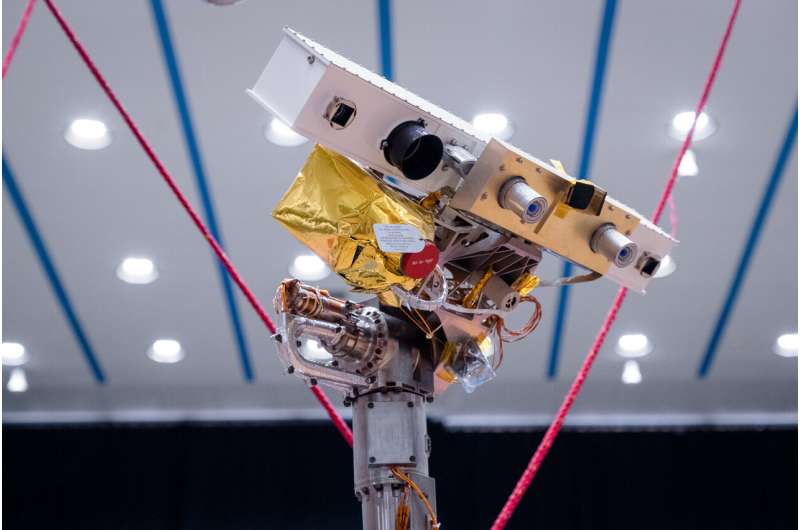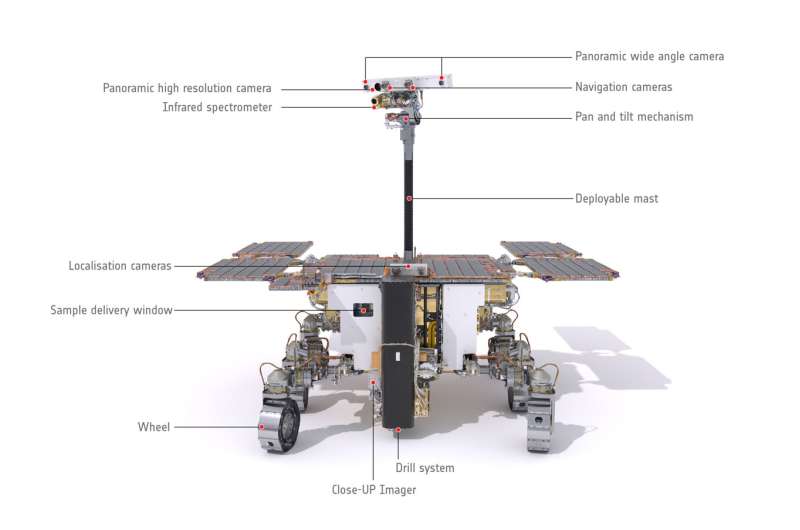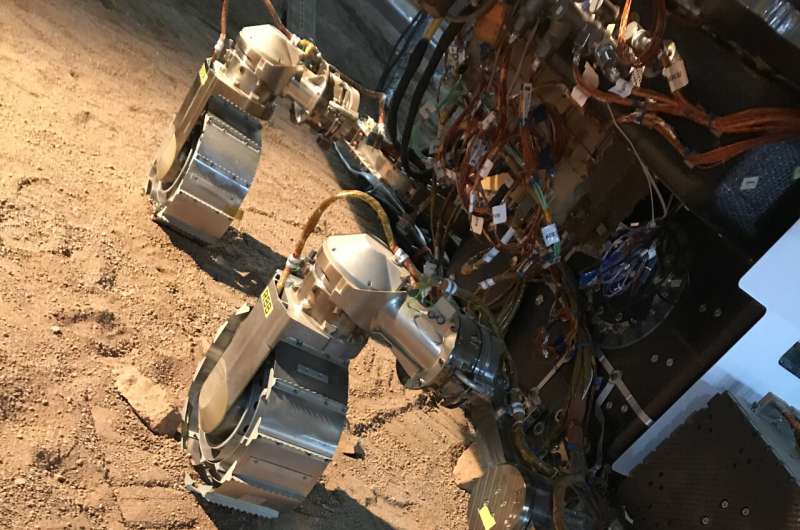Two stereo cameras at the top and at the bottom of the rover’s mast – NavCam and LocCam – allow the GTM to ‘see’ in three dimensions and identify the rocks and slopes ahead. The cameras guide the rover through safe paths and help avoid hazards. Once the rover is on the move, two more sets of cameras – PanCam and CLUPI – come into play to get a whole picture of the site with high resolution imaging. These rover ‘eyes’ send panoramic and close-up images of the terrain to the operators at the Rover Operations Control Centre (ROCC). The images are essential to map the geological context and to help the scientists decide where the rover should stop and survey the surface in more detail. Credit: Thales Alenia Space
ESA's ExoMars rover is confirmed technically ready for launch, and a fast-track study is under way to determine options for bringing the mission to Mars.
The ESA-led Rosalind Franklin rover has a unique potential to search for evidence of past life on Mars thanks to its drill and laboratory. It will be the first rover to drill 2 m below the surface, and the first to use novel driving techniques, including wheel-walking, to overcome obstacles.
Although the 2022 launch window for the mission is no longer possible following the suspension of cooperation with Roscosmos, the mission's System Qualification and Flight Acceptance Review took place as planned in March. The Review Board confirmed that the spacecraft would have been ready for the timely shipment to the launch site and the program had a sufficient time margin for the original launch opportunity opening on 20 September 2022.
Due to the suspension of the 2022 launch, the Exomars elements are now being prepared for storage at a Thales Alenia Space site in Italy awaiting further instruction.
The Review Board members specifically expressed their appreciation and thanks to the review team for the exhaustive work performed over the past months.
Artist’s impression of the Rosalind Franklin ExoMars rover. This image shows a front view of the rover with the drill in a vertical position. Credit: ESA/Mlabspace
Based on the decision by ESA Member States at its March Council meeting, a fast-track industrial study will now start to better define the available options for a way forward to implement the ExoMars rover mission in a future launch.
The teams will be looking for the earliest possible launch depending on how quickly technologies can be developed to support a European-led mission, or in collaboration with other international partners, and the availability of compatible launchers and launch site.
"I hope that our Member States will decide that this is not the end of ExoMars, but rather a rebirth of the mission, perhaps serving as a trigger to develop more European autonomy," says David Parker, Director of Human and Robotic Exploration at ESA.
"We count on brilliant teams and expertise across Europe and with international partners to reshape and rebuild the mission. The team is dedicated and focused on setting out the next steps to ensure we bring this incredible rover to Mars to complete the job it was designed for."
ESA's Rosalind Franklin the rover has six wheels and a unique way of moving across the Red Planet. Each wheel pair is suspended on a pivoted bogie so each wheel can be steered and driven independently. Rosalind’s twin on Earth, known as Amalia, has successfully left the platform in a Mars terrain simulator at the ALTEC premises in Turin. The test model borrows its name from renowned astrophysicist Professor Amalia Ercoli Finzi. Amalia was the first woman to graduate in aeronautical engineering in Italy, and she strongly pushed for the development of the ExoMars drill already 20 years ago. Engineers are using the Amalia rover to recreate different scenarios and help them take decisions that will keep Rosalind safe in the challenging environment of Mars. The model is fully representative of what the rover will be able to do on the Red Planet. Amalia has so far demonstrated drilling soil samples down to 1.7 meters, drive through rough terrain and operate all the instruments while sending scientific data to the Rover Operations Control Centre (ROCC), the operational hub that will orchestrate the roaming of the European-built rover on Mars. Credit: ESA
Meanwhile, the ExoMars Trace Gas Orbiter (TGO) continues to relay the majority of data from Mars, from NASA's Curiosity and Perseverance rovers as well as its Insight lander. TGO has considerable fuel onboard meaning it could also support data relay from the ExoMars rover in the future as well the Mars Sample Return campaign.
Provided by European Space Agency

























